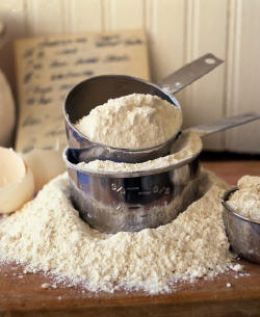Una explicación de los diferentes tipos de harina disponibles, ¿Y qué tipo es adecuado para sus necesidades de hornear particulares?.
No se necesita un científico de cohetes para darse cuenta de que la harina de pastel es buena para el pastel, y la harina de pan es buena para ... espera ... pan! Pero por qué, ¿Y por qué algunas harinas para todo propósito parecen hacer un gran pan?, y otros resulta decepcionantes panes, y lo que diablos es la harina de cría de todos los de todos modos?
La principal diferencia entre los diferentes tipos de harina es la cantidad del germen de trigo y el salvado que están molidos con la harina., and the type of wheat used for the flour, and the relative protein content of that wheat.
Whole wheat flour is simply wheat that has been milled into flour with some, or all, of the germ and bran still attached.
Additionally, different varieties of wheat contain different amounts of protein, and the more protein is contained in the flour, the higher gluten it has.
Gluten are the strands of amino acid proteins that bind together in a bread dough after the mixture of water, and the creation of longer and stronger chains of gluten through mechanical mixing (kneading). The higher the protein content, the more gluten can be developed. These chains of gluten are important for bread, as they are what allow the dough to capture the created gasses during the cooking and leavening processes, and expand from dense to light. High gluten is not considered an asset when making pastries, pie crusts, biscuits etc, as the gluten can make these tough and chewy.
The protein contents are approximately:
Cake flour:7-8%
Southern all purpose flour:7.5-9.5%
Northern all purpose flour:11-12%
Bread flour:12-13%
There is a difference between all purpose flour from the southern climates, and that from more northern climates, and the more northerly grown the wheat, the higher the gluten content. This can explain why an all purpose flour bought in Wisconsin makes a great bread, and an all purpose flour bought in Alabama doesn’t.
Whole wheat flour is high in protein, but the protein from the germ and bran is not well turned into gluten, and as such, whole wheat breads tend to be heavier, but more flavorful then white flour breads. Rye bread contains very little gluten, and as such 100% rye breads are very dense.
Cake flour is a low gluten flour that has also been chemically altered slightly for better use in cake baking.
Self raising flour is generally all purpose flour that has had baking powder mixed in, and do not require any additional baking powder to be added when making biscuits, pancakes or muffins.
So, if you are making bread, use a northern all purpose, or bread flour, and if making pastry, use a southern all purpose, cake or pastry flour. Always look for flour labeled unbleached, as it tastes better, and store whole wheat flour in the fridge or freezer.
The reason that you spend so much time kneading when making a breads dough, is to create lots of these strong gluten chains, and if you under knead, your bread will generally fail to rise well.
Don’t worry too much about it all though, as most of the time, using whatever flour you have on hand will work out just fine, and you should never not bake that apple pie, just because you only have bread flour on hand. Bake those cookies; make that bread, and enjoy the aroma of home baking; it’s always appreciated.


